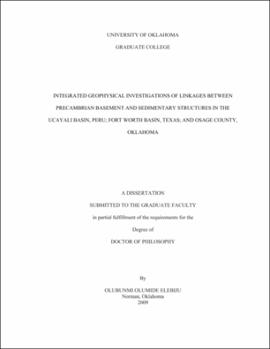| dc.contributor.advisor | Keller, George R||Marfurt, Kurt J | |
| dc.creator | Elebiju, Olubunmi Olumide | |
| dc.date.accessioned | 2019-05-01T17:24:32Z | |
| dc.date.available | 2019-05-01T17:24:32Z | |
| dc.date.issued | 2009 | |
| dc.identifier | 99132361602042 | |
| dc.identifier.uri | https://hdl.handle.net/11244/319463 | |
| dc.description.abstract | I conducted integrated geophysical studies within the Fort Worth basin, Texas; Osage County, Oklahoma, and the Ucayali basin, Peru. My studies are directed at understanding the relationships or links between Precambrian basement structures and sedimentary structures using these three areas as case studies. Links between basement structure, hydrocarbon reservoirs, and sedimentary sequences are not a new concept. Such relationships have been documented in the Paradox, Hardeman, Anadarko, Arkoma, Ardmore and Williston basins among others. Structures such as fault zones that can influence the formation of sedimentary basins and mineral deposits are often formed by intraplate tectonism. | |
| dc.description.abstract | In order to compare the relationship between the Precambrian basement structures and sedimentary structures, I analyzed series of derivative and filtered maps of aeromagnetic and gravity data, which enhance basement structures, that were integrated with seismic data and seismic attribute data that enhance structures within the sedimentary sections. Other information such as well data and geologic information etc were also integrated. This integrated workflow facilitates the comparison of the links or relationships between the two structures. | |
| dc.description.abstract | The results of the Fort Worth basin are presented in Chapter 3. The results of this integrated study show that the sedimentary structures within the study area are mainly related to basement structures because these structures are aligned parallel to anomalies identified on the high-resolution aeromagnetic (HRAM) data. The northeast-southwest and northwest-southeast orientations of sedimentary features are consistently parallel with Precambrian structural fabrics that are associated with structures such as the northeast trending Ouachita orogenic belt and the northwest trending Muenster Arch, which reactivated a late Cambrian/Late Precambrian faults. The knowledge gained in this study will impact oil and gas exploration and development within the study area because, the orientation of the natural and induced fractures can be predicted even if seismic data is limited or unavailable. | |
| dc.description.abstract | In Chapter 4, the results of an integrated analysis that includes the use of 3D seismic data, seismic attributes, and derivative maps from potential field data to study the basement, Mississippi Chert and the Arbuckle Group of Osage County, Oklahoma are presented. The workflow employed in this study was effective in studying and identifying polygonal, highly coherent, and high amplitude lineaments that strike northwesterly and northeasterly within these reservoirs. Basement structure lineaments are found to be parallel in orientation with the trend of lineaments seen within the Mississippian Chert and the Arbuckle Group. The northwest-striking lineaments may be related to the late-Paleozoic tectonism that affected both the Precambrian and Paleozoic section of Osage County. Another part of this research investigated the large gravity and magnetic anomalies and their association with the Mid-Continent Rift System (MCRS). Results of this analysis revealed prominent northeast trending anomalies that suggest that the MCRS extends into northern Oklahoma. However, geochronological data for basement rocks suggest that this extension would have to be limited to intrusive bodies that have little or no subcrops. | |
| dc.description.abstract | The integrated study conducted in the Ucayali basin of Peru revealed that the northwest-southeast trending lineaments interpreted as Precambrian basement structures are sub-parallel to the late Paleozoic fold and thrust belts that resulted from the shortening associated with the formation of the Andes. These fold and thrust belts are reactivated along the zones of weaknesses that already existed in the Precambrian basement. The east-northeast lineaments are located beneath the Fitzcarrald Arch locate above the buoyant Nazca ridge. I interpret these east-northeast lineaments as part of the Ene Pisco - Abancay Fitzcarrald tectonic lineaments, which is one of the five tectonic domains in these region. Gravity modeling suggests that the crustal thickness and the subduction slab-dip beneath Peru increase from the north of the Ucayali basin towards the south. My 2-dimensional gravity model suggests that the crust thickness and Nazca plate dip increase southward within the Ucayali basin. These results also establish a correlation between known geologic features and the regional gravity anomalies | |
| dc.format.extent | 194 pages | |
| dc.format.medium | application.pdf | |
| dc.language | en_US | |
| dc.relation.requires | Adobe Acrobat Reader | |
| dc.subject | Geology, Stratigraphic--Precambrian | |
| dc.subject | Geology, Structural--Peru--Ucayali River Valley | |
| dc.subject | Geology, Structural--Texas--Fort Worth Basin | |
| dc.subject | Geology, Structural--Oklahoma--Osage County | |
| dc.title | INTEGRATED GEOPHYSICAL INVESTIGATIONS OF LINKAGES BETWEEN PRECAMBRIAN BASEMENT AND SEDIMENTARY STRUCTURES IN THE UCAYALI BASIN, PERU; FORT WORTH BASIN, TEXAS; AND OSAGE COUNTY, OKLAHOMA | |
| dc.type | text | |
| dc.type | document | |
| dc.thesis.degree | Ph.D. | |
| ou.group | Mewbourne College of Earth and Energy::ConocoPhillips School of Geology and Geophysics | |
